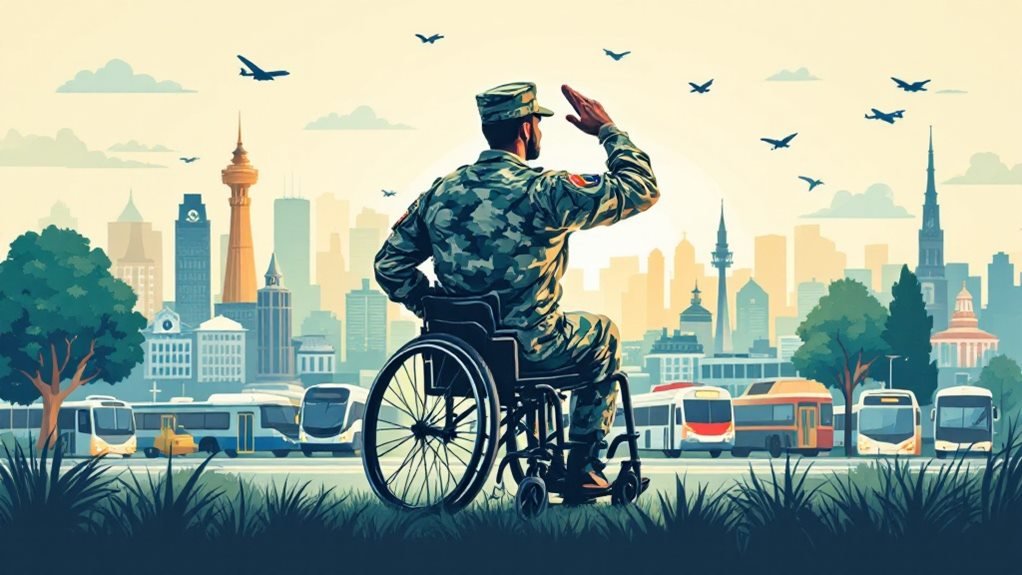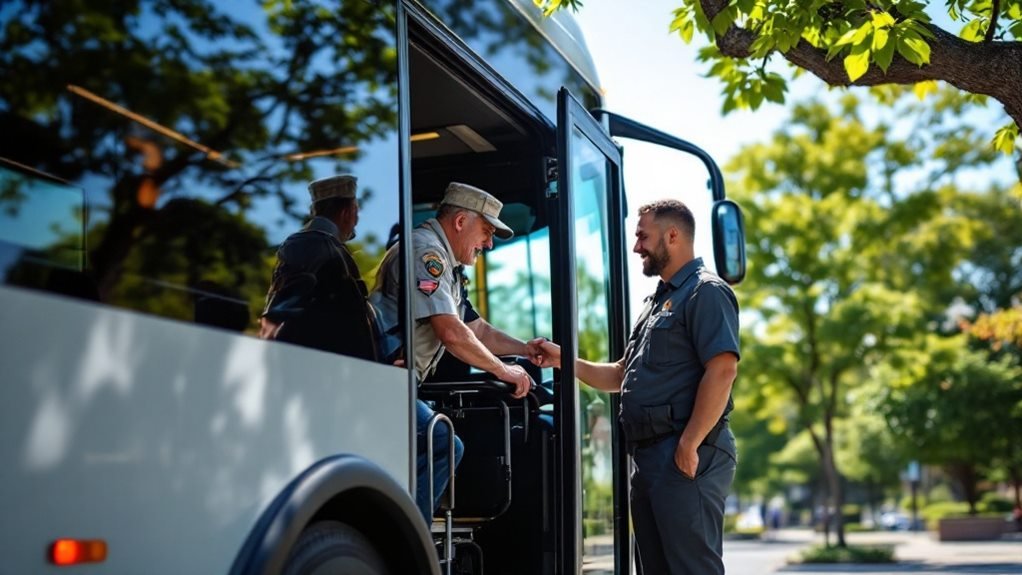If we qualify for Veterans Transportation Service (VTS), we must meet several criteria. First, our veteran status needs verification through military ID or discharge papers. We also need a service-connected disability recognized by the VA. Enrollment in VA healthcare confirms access to this service. Living far from a VA facility potentially enhances eligibility, especially if public transportation is lacking. Our income level and financial need are assessed, needing verified proof of income. Finally, special circumstances can be considered with appropriate documentation. It's crucial to understand these criteria fully, as they decide if we gain access to this valuable service.
Key Takeaways
- Veterans must verify their status with military ID or discharge papers to be eligible for VTS.
- Eligibility requires veterans to have a service-connected disability with a VA-determined disability rating.
- Veterans living far from VA facilities may qualify for VTS based on geographic location.
- Income evaluation is necessary, prioritizing veterans with genuine financial need for VTS.
- Special circumstances like financial hardships can influence VTS eligibility with proper documentation.
Veteran Status Requirements
To qualify for the Veterans Transportation Service (VTS), it's essential to understand the veteran status requirements. We must first verify that a person is indeed a veteran. This involves veteran identification, which typically includes a military ID, discharge papers, or other official documentation. These documents not only confirm identity but also validate the duration of service, which plays a significant role in eligibility.
Our responsibility is to guarantee that those who served meet the necessary criteria to access the support they deserve. The service duration required may vary, but generally, an individual must have served on active duty for a specific period, often more than 90 days. These details aren't just bureaucratic necessities; they honor the commitment and sacrifices made by our veterans.
We understand that maneuvering through these requirements might feel overwhelming. It's our duty to assist and guide veterans through this process with empathy and clarity.
Service-Connected Disabilities
When we consider service-connected disabilities, it's essential to understand how disability ratings are determined and what criteria make someone eligible for VTS.
We'll explore the specific requirements and guide you through the application process, ensuring clarity every step of the way.
Together, we'll navigate these details to help you access the support you deserve.
Determining Disability Ratings
Understanding how disability ratings are determined for service-connected disabilities is essential for veterans seeking benefits. We must grasp the disability determination process and the rating criteria used by the Department of Veterans Affairs (VA).
These ratings are vital as they directly impact the level of benefits a veteran can receive. The VA evaluates the severity of a veteran's disability by using a percentage system ranging from 0% to 100%, in increments of 10%. This percentage represents the degree to which the disability affects the veteran's ability to work and perform daily activities.
In our pursuit to serve those who've served us, we need to understand that the VA uses a schedule of rating criteria specific to different disabilities. These criteria consider factors like medical history, treatment records, and results from VA medical examinations.
It's important for us to assist veterans in ensuring all relevant medical documentation is thorough and up-to-date, as this influences the accuracy of the disability rating assigned. By helping veterans navigate this complex system, we empower them to better access the benefits they've earned, enabling a smoother changeover to civilian life and ensuring they receive the support they deserve.
Eligibility Criteria Explained
While we've examined how disability ratings are assigned, it's equally important to address who qualifies for these evaluations in the first place. As we explore the eligibility criteria for service-connected disabilities, our mission is to enhance veteran outreach and eligibility awareness. Understanding these criteria guarantees we can support those who've served with the respect and care they deserve.
Service-connected disabilities are identified when an injury or illness was incurred or aggravated during active military service. To qualify, veterans must demonstrate a direct connection between their service and the medical condition. This can involve medical records, service documents, and sometimes, supportive statements from fellow service members.
Our role is to help veterans navigate these requirements, guaranteeing no deserving individual is overlooked.
Furthermore, certain conditions are presumed to be service-connected based on circumstances like exposure to hazardous materials or time served in specific locations. By raising eligibility awareness, we empower veterans to recognize their rightful benefits.
It's our duty to stand by them, providing guidance and support throughout this process. Together, we can guarantee that every veteran receives the acknowledgment and assistance they've earned through their service.
Application Process Overview
Steering the application process for service-connected disabilities requires a clear understanding of each step involved. We understand traversing this journey can feel overwhelming, but with the right guidance, it becomes manageable.
First, we must gather essential documents, including medical records and proof of service, which form the backbone of our application. Understanding the application timeline is vital; typically, processing can take several months. Staying informed about each phase helps us manage expectations and follow up when necessary.
Next, we should explore eligibility resources available to us. These resources, such as the VA website or local veteran service organizations, provide invaluable support, answering questions and offering assistance throughout the process.
We must guarantee our application is complete and accurately reflects our condition to avoid delays. After submission, we can track our application's progress online, ensuring we're aware of any updates or additional documentation requests.
Remember, patience and persistence are key. By staying organized and utilizing available resources, we strengthen our case for receiving the benefits we deserve.
Let's approach this process with determination, recognizing that every step brings us closer to the support aimed at enhancing our well-being.
Enrollment in VA Healthcare
Enrolling in VA Healthcare is an essential step for veterans seeking access to extensive medical services. As we navigate this process together, let's remember that it opens doors to numerous enrollment benefits tailored to meet the unique needs of those who served.
By enrolling, veterans can access a thorough range of veteran healthcare options, including routine check-ups, specialized treatments, and mental health support. This system is designed to honor our service by ensuring we receive the care we deserve.
To begin enrollment, we need to gather necessary documents like our DD214 or other discharge papers, which verify our military service. It's important to complete the VA Form 10-10EZ, Application for Health Benefits, ensuring all details are accurate to prevent delays.
We can submit this form online, by mail, or in person at a local VA facility. Once enrolled, we gain access to services that can greatly improve our quality of life, from preventive care to cutting-edge medical treatments.
Distance From VA Facility
Let's explore how the distance from a VA facility can impact VTS eligibility.
We understand that proximity requirements and mileage limits play a vital role in determining coverage for veterans who need transportation services.
It's important to comprehend these criteria to guarantee that those who live farther away from facilities receive the support they need.
Proximity Requirements for Eligibility
Understanding the proximity requirements for Veterans Transportation Service (VTS) eligibility is important for veterans seeking access to healthcare. As we explore these requirements, we take into account several proximity factors and geographic considerations that can affect a veteran's eligibility. The main aim is to guarantee that no veteran is left without access to essential healthcare services due to distance barriers.
These factors help determine if a veteran lives too far from a VA facility to reasonably access care independently. We need to evaluate how proximity to a VA facility impacts eligibility. Veterans who reside in remote or rural areas often face significant challenges when trying to access healthcare services.
The geographic location plays a key role here. For instance, veterans living in areas without adequate public transportation options may have a stronger case for VTS eligibility. It's important for us to take these unique circumstances into account and guarantee that transportation services are available to those who need them most.
When we assess these proximity requirements, we're not just looking at distance. We're analyzing the broader context of each veteran's situation, ensuring we serve them effectively and compassionately. Understanding these factors helps us advocate for our veterans' needs.
Mileage Limits and Coverage
Maneuvering the mileage limits for VTS eligibility can greatly impact a veteran's ability to access necessary healthcare services.
We recognize how vital it's for veterans to receive the care they deserve, without the burden of distance becoming a barrier. The Veteran Transportation Service (VTS) offers a lifeline by bridging the gap between veterans and VA facilities, but it's essential we grasp the specifics of mileage reimbursement and coverage limits to maximize this support.
The VTS program typically considers the distance from a veteran's home to the nearest VA facility. Eligible veterans who live a considerable distance away may qualify for transportation services or reimbursement.
While specific coverage limits can vary, the goal is to guarantee that veterans aren't financially strained by their healthcare commutes. It's important we carefully review these limits to ensure our veterans receive all available benefits.
Income and Financial Need
Evaluating eligibility for the VTS program involves a close look at income and financial need. We recognize that financial circumstances can greatly impact one's ability to access transportation services. Our aim is to guarantee that those who truly need financial assistance receive it. This involves a thorough process of income verification to assure fairness and accuracy.
By evaluating income, we can provide support where it's needed most, empowering individuals to access essential services and improve their quality of life.
Our approach is rooted in empathy and a deep commitment to serving others. We acknowledge that behind every application is a story of individual need and potential.
Income verification is a crucial step in determining eligibility, as it helps us allocate resources effectively and equitably. We endeavor to create a transparent and supportive process, minimizing barriers for those seeking help.
Our goal is to guarantee that financial assistance reaches those who are most in need, allowing them to move forward with dignity and confidence.
Required Documentation
As we assess financial need, gathering the right documentation becomes a key step in guaranteeing fair access to the VTS program.
It's important we all understand what documents are necessary and how to submit them correctly. With empathy and clarity, we aim to make this process as smooth as possible. Our goal is to guarantee each applicant is able to demonstrate their eligibility accurately.
To start, let's look at some required documentation examples.
You'll need to provide proof of income, such as recent pay stubs or a letter from your employer. Tax returns from the previous year are also crucial to give us a thorough view of your financial situation. If you're self-employed, a profit and loss statement will be necessary. Additionally, bank statements from the past three months can help substantiate your financial status.
Once you've gathered these documents, follow our submission guidelines carefully.
Confirm all documents are legible and up-to-date. Submissions should be made through our secure online portal, where you can easily upload files. Remember, accurate documentation is essential for us to serve you better and support your access to the VTS program.
We're here to help every step of the way.
Special Circumstances Eligibility
Steering through the complexities of eligibility can be challenging, especially when unique situations arise. We comprehend that life's unpredictability often leads to circumstances that aren't covered by standard guidelines.
For those experiencing financial hardships or other unique situations, the path to eligibility for VTS feels intimidating. Rest assured, there are provisions in place to accommodate these needs, guaranteeing that everyone receives fair consideration.
First, we must identify what defines a "special circumstance." It could be sudden unemployment, unexpected medical expenses, or other significant life changes affecting financial stability.
Our goal is to make certain these unique situations don't go unnoticed, offering a lifeline to those in need.
To apply under special circumstances, we'll need detailed documentation outlining your financial hardships. It's essential for you to provide as much information as possible, allowing us to assess your situation accurately.
We're dedicated to evaluating each case with empathy and awareness, tailoring our approach to best support you.
Conclusion
In summary, understanding who's eligible for Veterans Transportation Service (VTS) can greatly impact access to critical healthcare. Did you know that over 9 million veterans are enrolled in VA healthcare, yet many face transportation challenges? We've navigated the requirements together, considering veteran status, service-connected disabilities, and financial need. Remember, having the right documentation and knowing special circumstances can make a difference. We're here to guarantee you get the support you deserve. Reach out if you need guidance!



